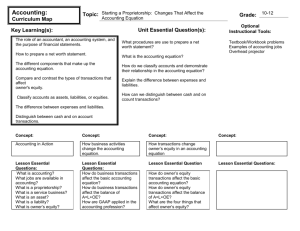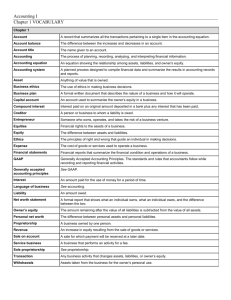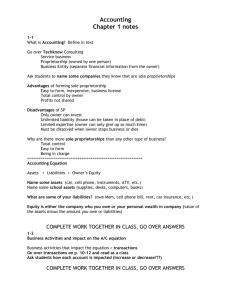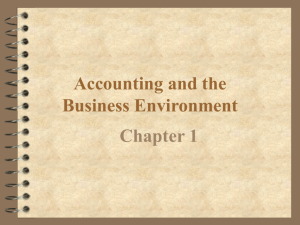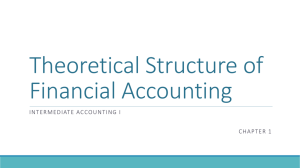Generally Accepted Accounting Principles (GAAP)
advertisement
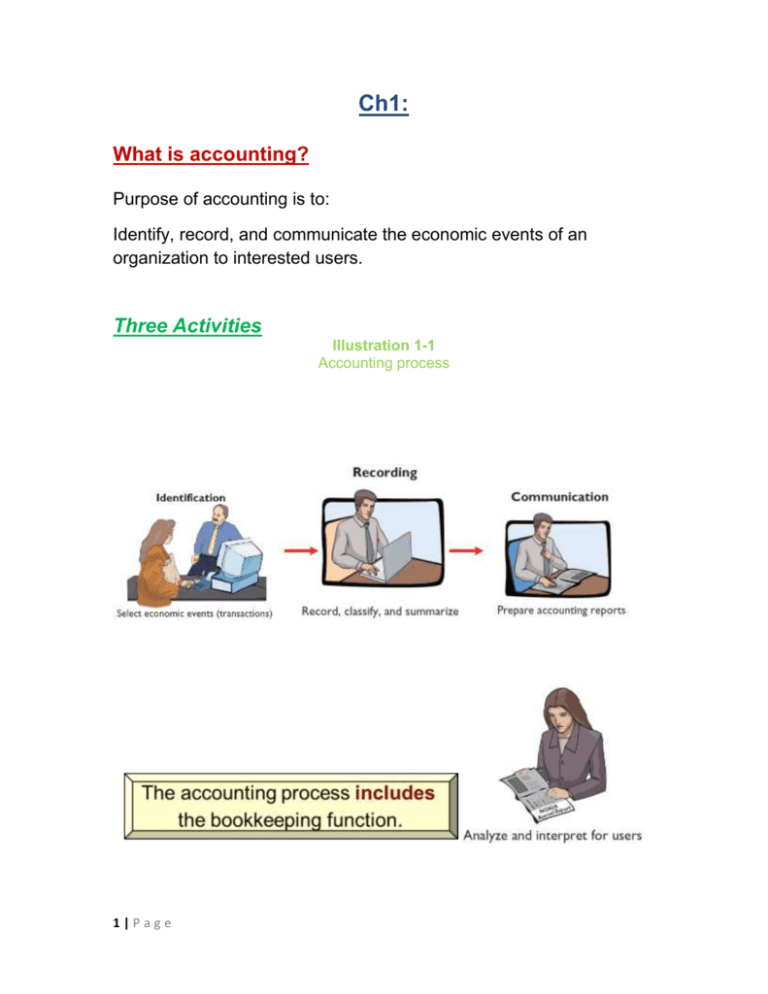
Ch1: What is accounting? Purpose of accounting is to: Identify, record, and communicate the economic events of an organization to interested users. Three Activities Illustration 1-1 Accounting process 1|Page Who Uses Accounting Data? There are two broad groups of users of financial information: internal users and external users Internal Users: Management. Human Resources. Finance. Marketing. External users: Investors. Labor Unions. Creditors. Customers. Generally Accepted Accounting Principles: Various users need financial information 2|Page The accounting profession has attempted to develop a set of standards that are generally accepted and universally practiced Generally Accepted Accounting Principles (GAAP). Generally Accepted Accounting Principles (GAAP) - A set of rules and practices, having substantial authoritative support that the accounting profession recognizes as a general guide for financial reporting purposes. Measurement Principles: Cost Principle – Or historical cost principle, dictates that companies record assets at their cost Assumptions: Monetary Unit – include in the accounting records only transaction data that can be expressed in terms of money. Economic Entity – requires that activities of the entity be kept separate and distinct from the activities of its owner and all other economic entities. Forms of Business Ownership: Proprietorship. Partnership. Corporation. 3|Page Proprietorship: Generally owned by one person. Often small service-type businesses Owner receives any profits, suffers any losses, and is personally liable for all debts. Partnership: Owned by two or more persons. Often retail and service-type businesses Generally unlimited personal liability Partnership agreement Corporation: Ownership divided into shares of stock Separate legal entity organized under state corporation law Limited liability Question: Combining the activities of Kellogg and General Mills would violate the a. Cost principle. b. Economic entity assumption. c. Monetary unit assumption. d. ethics principle. A business organized as a separate legal entity under state law having ownership divided into shares of stock is a a. Proprietorship. b. Partnership. c. Corporation. d. 4|Page Sole proprietorship. The Basic Accounting Equation: Assets =Liabilities + Owner’s Equity Provides the underlying framework for recording and summarizing economic events. Assets are claimed by either creditors or owners. Claims of creditors must be paid before ownership claims. Assets Resources a business owns. Provide future services or benefits. Cash, Supplies, Equipment, etc. Assets=Liabilities+ Owner’s Equity Liabilities Claims against assets (debts and obligations). Creditors – party to whom money is owed. Accounts payable, Notes payable, etc. o Assets=Liabilities+ Owner’s Equity. Owner’s Equity Ownership claim on total assets. Investment by owners and revenues (+) Drawings and expenses (-). • 5|Page Assets=Liabilities+ Owner’s Equity Revenues result from business activities entered into for the purpose of earning income. Common sources of revenue are: sales, fees, services, commissions, interest, dividends, and rent. Expenses are the cost of assets consumed or services used in the process of earning revenue. Common expenses are: salaries expense, rent expense, utilities expense, tax expense, etc. Using the Accounting Equation Transactions are a business’s economic events recorded by accountants. May be external or internal. Not all activities represent transactions. Each transaction has a dual effect on the accounting equation. Illustration: Are the following events recorded in the accounting records? Criterion: Is the financial position (assets, liabilities, or owner’s equity) of the company changed? Event Supplies are purchased on account An employee is hired Owner withdraws cash for personal use. 6|Page Record/ Don’t Record Record Don’t Record Record Financial Statements: Companies prepare four financial statements: Income Statement. Owner’s Equity Statement. Balance Sheet. Statement of Cash Flows. Question: Net income will result during a time period when: a. Assets exceed liabilities. b. Assets exceed revenues. c. Expenses exceed revenues. d. Revenues exceed expenses. 7|Page 8|Page 9|Page The balance sheet and income statement are needed to prepare statement of cash flows. Statement of Cash Flows: Information for a specific period of time. Question: Which of the following financial statements is prepared as of a specific date? a. Balance sheet. b. Income statement. c. Owner's equity statement. d. Statement of cash flows. 10 | P a g e 11 | P a g e

